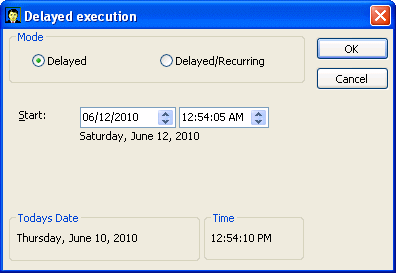A pipeline in an application executes when you execute it manually or when you set a delayed execution mode to automatically execute the pipeline.
The execution mode (Manual by default) shows in the Execution Mode box. If you set a delayed execution mode, the time settings and a countdown clock display in the When box.
You can manually execute a pipeline anytime, even if you have set a delayed execution mode.
![]() To execute the pipeline manually:
To execute the pipeline manually:
Click the Execute button.
You can specify delayed automatic execution of the pipeline. This setting remains in effect until you close the Pipeline window.
![]() To delay the execution of the pipeline:
To delay the execution of the pipeline:
Select Actions>Delayed Execution from the menu bar.
The Delayed Execution dialog box displays.
Select the Delayed radio button if it is not already selected:

In the Start boxes, specify the execution date and time.
The day, month, numerical day, and year for the date you specify display under the Start boxes. You should verify that this date is the date you want, because the date is based on the operating system’s short date setting. For example, a date of 04/12/06 could mean April 12, 2006, or December 6, 2004.
Click OK.
The pipeline will execute at the specified date and time.
You can specify delayed and recurring automatic execution of the pipeline. This setting remains in effect until you close the Pipeline window.
![]() To delay and repeat the execution of the pipeline
at specified intervals:
To delay and repeat the execution of the pipeline
at specified intervals:
Select Actions>Delayed Execution from the menu bar.
The Delayed Execution dialog box displays.
Select the Delayed/Recurring radio button.
In the Start boxes, specify the execution date and time.
The day, month, numerical day, and year for the date you specify display under the Start boxes.
In the Every boxes, specify the time delay for subsequent executions of the pipeline.
Click OK.
The pipeline will execute at the specified start time and then execute repeatedly.
If execution errors occur, the errors display in the Pipeline Errors box. You can print the errors or save the errors to any report format. You can sometimes correct errors in the Pipeline Errors box.
Users of the application usually should not repair pipeline execution errors. Users should contact you if execution errors occur and send the error log to you for debugging of the pipeline. Usually you should modify the pipeline object in InfoMaker to fix errors and redeploy the application.
At times, you may want users to fix execution errors by modifying the pipeline definition from the application. Advanced users of the application can modify the application’s initialization file to allow them to change the pipeline object’s definition from the application. You can tell users how to do this if needed.
For information about adding a [Pipe] section to the initialization file, see “Modifying the pipeline object’s definition”.
When a pipeline executes and has execution errors, the error messages display in the Pipeline Errors box in the workspace and instructions for repairing the errors display in a message box.
In the Pipeline Errors box, look at the Error Message column to identify errors.
Change the data values for the appropriate columns in the error rows.
You can extend the column borders to resize the column to the width needed to see error messages and column data.
Click the Repair button to execute the pipeline.
If errors have been corrected, the pipeline executes and the Pipeline Errors box clears.